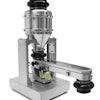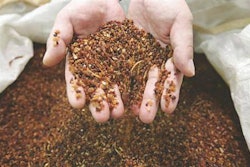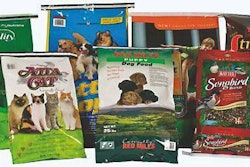Oxidized fat for racing Greyhounds
Racing dogs are often fed raw meat, which may become oxidized. Few studies have examined the effect of feeding oxidized food. This study was originally designed to determine the effect of different concentrations of dietary fat on Greyhound performance. After the experiment had been completed, it was discovered that the peroxide values of both diets were elevated, indicating that fat oxidation had been present.
The study compared performance and blood parameters in eight trained Greyhounds fed either a high fat moderately oxidized (HFMO) diet or a medium fat highly oxidized (MFHO) diet for eight weeks. Dogs were raced over 500 m twice weekly. Dogs fed the MFHO food ran 0.04 m/s slower (p = 0.06) and serum alkaline phosphatase concentrations were higher (149 vs. 56 U/L; p < 0.0001) than in dogs fed the HFMO diet. Further evaluation is needed to determine whether lower dietary fat or increased oxidation was responsible for the altered performance, but oxidation of the food should be considered as one possible explanation for an increase in serum alkaline phosphatase during a diet trial.
Oxidative stress in diabetic cats
Increasing evidence implicates oxidative damage in the progression and complications of human diabetics. This study assessed antioxidant status and oxidative stress in cats with diabetes mellitus (DM, n = 10) and a control group (n = 10).
Alpha tocopherol was increased and gamma tocopherol was decreased in diabetic vs. control cats. Fructosamine was greater in diabetic vs. control cats. Antioxidant status/oxidative stress was not associated with glycaemic control in diabetic cats.
Despite strong association of DM with oxidative stress in humans, this simple relationship is not found in diabetic cats. They have both increased and decreased parameters of systemic oxidative stress compared with control cats. This may be due to higher levels of antioxidants in feline therapeutic diets, the relatively short duration of disease in cats or other factors.
Dogs in community households
The purpose was to investigate the feasibility of performing an epidemiological analysis of dietary patterns and health of dogs living in community households. The study included 50 humans and their canine companions. Questionnaires administered to the 50 participants included questions on demographics, activity, diet recall, food frequency and general health. Three-day food recalls were validated against food frequency data.
The results revealed 24% of canines enrolled were diagnosed as obese by their veterinarians, which was consistent with self-reported weight status, where 11 subjects reported an overweight dog (22%). Of the 50 respondents, 38 stated their companion animals were at an ideal weight (76%) and one stated the companion animal was slightly underweight (2%). The majority of companion animals were standard to large size (32%). The average age of the dogs sampled was 5 years.
The majority of subjects fed their canines treats daily (94%). Also a majority fed a premium, commercially available dry dog food, with another 14% feeding a commercially available specialized diet and one respondent feeding a prescription diet. Further research is needed to elucidate relationships between health status and dietary patterns in dogs.




(1).png?auto=format%2Ccompress&fit=crop&h=167&q=70&w=250)











